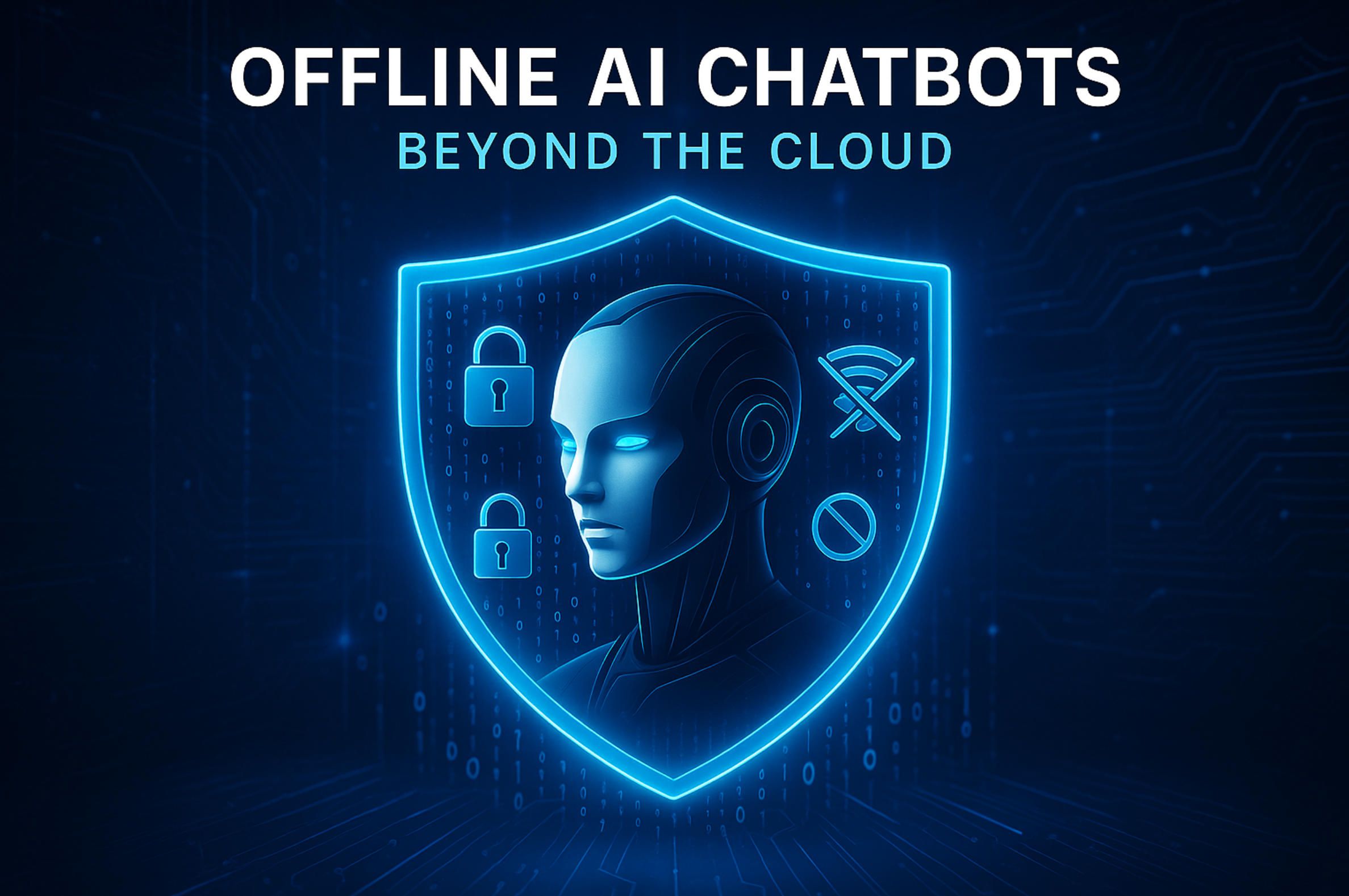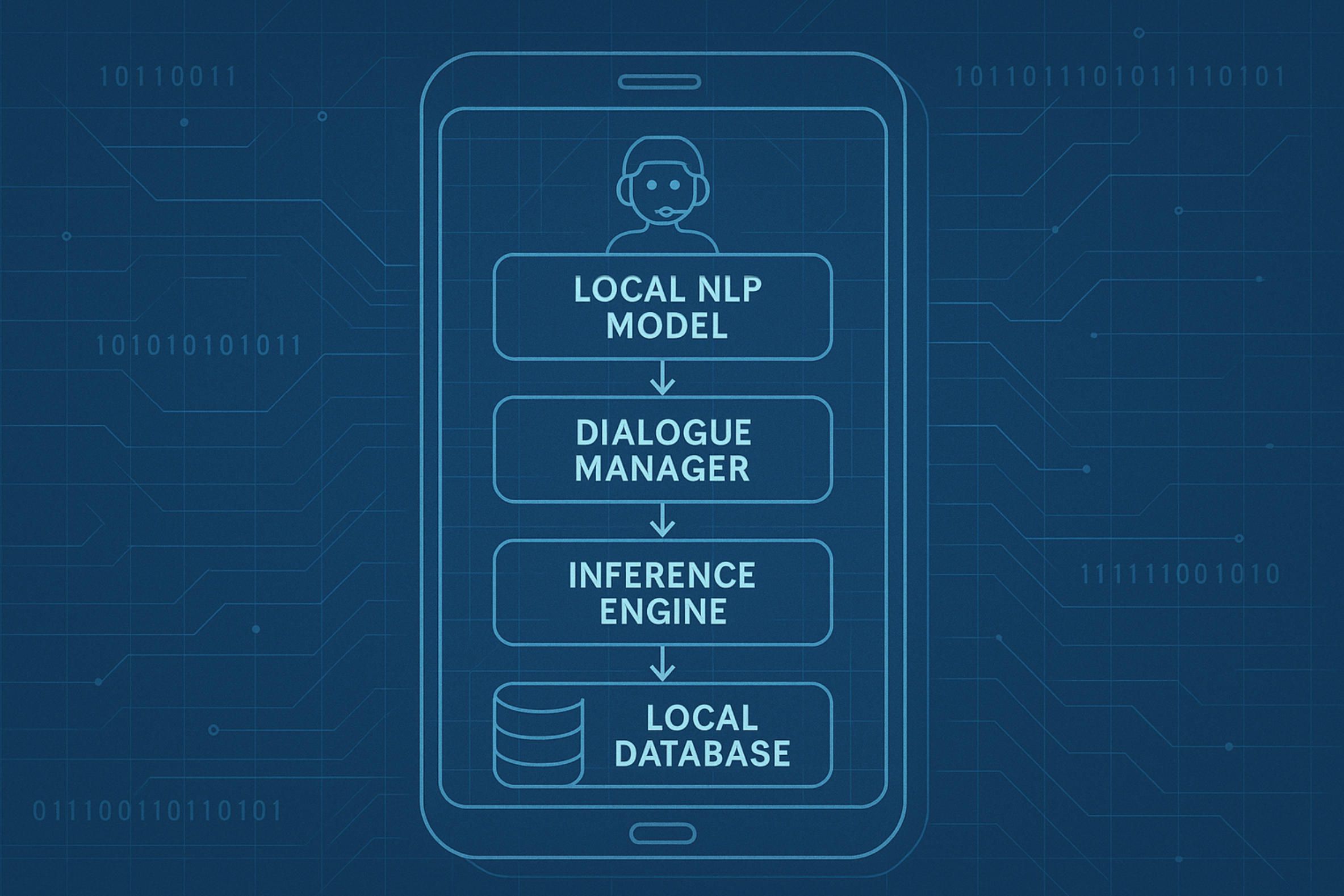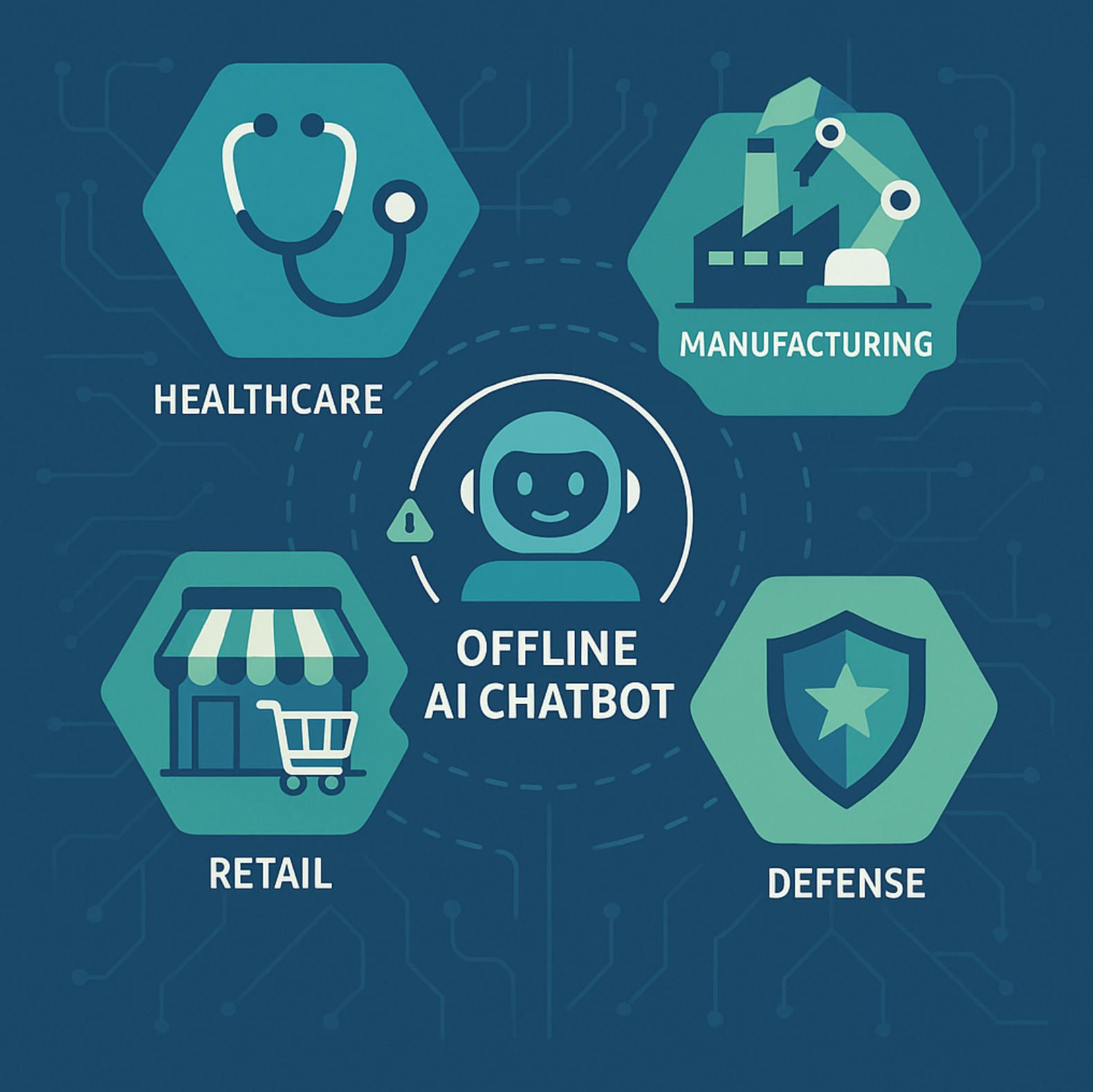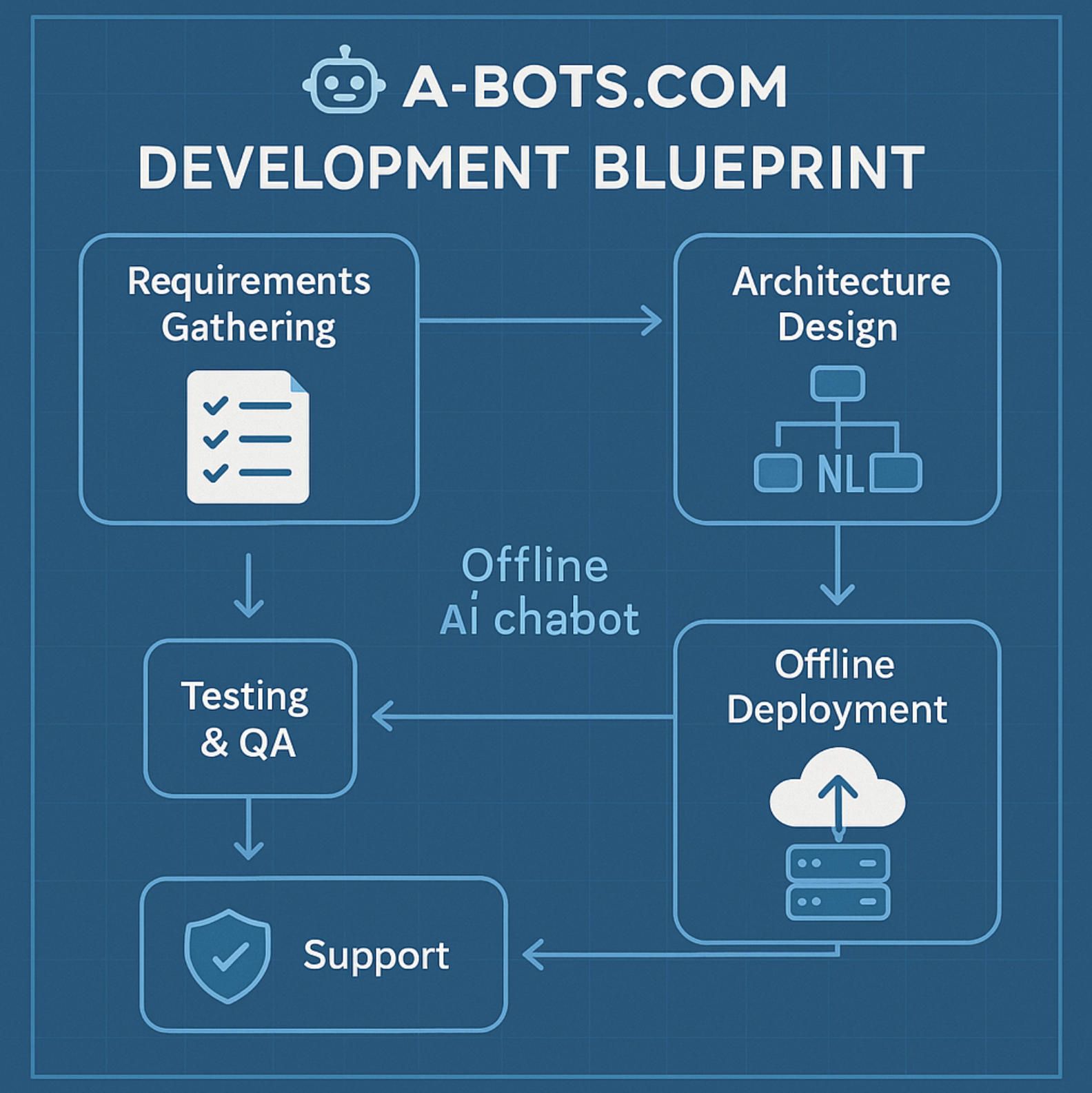
Home
Services
About us
Blog
Contacts
Offline AI Chatbot Development: Secure, Private, and Always Available
1. Why Offline? Exploring the Benefits of Offline AI Chatbot Development
2. Technical Deep Dive: How Offline AI Chatbots Work
3. Real-World Applications and Case Studies
4. How A-Bots.com Develops Custom Offline AI Chatbots
In the rapidly evolving landscape of artificial intelligence, chatbots have transformed how businesses engage customers, automate tasks, and deliver instant support. Traditionally, these conversational interfaces rely heavily on cloud-based services, requiring a persistent internet connection to function effectively. However, the growing demand for enhanced privacy, robust security, and consistent availability has paved the way for offline AI chatbot development—a specialized approach enabling AI-powered conversations entirely independent of internet connectivity.
Offline chatbots are particularly appealing in environments where sensitive data protection, minimal latency, or uninterrupted service is crucial. Industries such as healthcare, defense, manufacturing, and remote infrastructure management increasingly seek solutions immune to network disruptions and security vulnerabilities inherent to cloud dependencies. According to Gartner, by 2026, over 60% of enterprises handling sensitive data will prioritize offline-capable AI systems to mitigate security risks and ensure continuous operation under challenging conditions.
Understanding this burgeoning demand, companies frequently search terms like "offline AI chatbot development" and "offline AI chatbot developer", highlighting a strong market interest in specialized expertise. This interest isn't superficial; it's driven by practical considerations such as data sovereignty regulations, critical infrastructure reliability, and real-time response requirements.
In this comprehensive guide, we'll delve deeply into the benefits, technologies, real-world applications, and the meticulous process behind creating offline AI chatbots. Whether you're exploring ways to secure your company's sensitive information, improve operational continuity, or reduce latency, understanding offline chatbot solutions is essential. Additionally, we’ll illustrate how A-Bots.com, an experienced offline AI chatbot developer, designs custom solutions that guarantee privacy, security, and availability tailored to specific business needs.
Join us as we explore why offline chatbots aren't just a novel idea but a strategic necessity for organizations striving for operational resilience and data integrity.

1. Why Offline? Exploring the Benefits of Offline AI Chatbot Development
In recent years, artificial intelligence has become deeply intertwined with various business processes, significantly enhancing customer interactions, operational efficiency, and decision-making capabilities. However, traditional AI chatbot solutions typically depend on constant connectivity to the cloud, posing significant vulnerabilities. As more businesses become aware of the risks associated with cloud-dependent systems, interest has surged in offline AI chatbot development. This interest is not merely driven by theoretical advantages but concrete, measurable benefits that significantly enhance business resilience, security, and efficiency.
Privacy & Data Security
A primary reason organizations are pivoting towards offline AI chatbot solutions is the critical need for privacy and stringent data security. Cloud-based solutions, despite their convenience, often become targets of cyber-attacks and data breaches. According to the Verizon Data Breach Investigations Report (2024), approximately 83% of data breaches involved external cloud services, exposing sensitive customer and operational information. Offline AI chatbots mitigate this vulnerability by processing and storing sensitive information locally, eliminating the inherent risks of transmitting data across networks.
Moreover, compliance requirements such as GDPR in Europe or HIPAA in the United States increasingly push companies toward offline data processing to meet stringent regulatory guidelines. By choosing offline AI chatbot development, businesses not only protect critical information but also simplify regulatory compliance through localized data storage and handling practices.
Reliability & Availability
Another compelling benefit driving the adoption of offline chatbots is enhanced reliability. Unlike cloud-dependent solutions, offline chatbots function independently of external network conditions, ensuring constant availability and uninterrupted interactions. This reliability becomes crucial in scenarios where stable internet connectivity is compromised or entirely unavailable—such as remote industrial sites, maritime operations, emergency response units, or rural healthcare facilities.
For instance, in the healthcare sector, offline AI chatbots facilitate the immediate processing of patient inquiries, medication management, and diagnostic support without relying on external connectivity, significantly reducing downtime and improving patient outcomes. Similarly, manufacturing plants employing offline AI chatbot solutions can continue to operate seamlessly despite temporary network outages, maintaining productivity and operational continuity.
Reduced Latency and Increased Efficiency
Offline chatbots also excel in reducing latency and increasing response speed, crucial attributes in environments where real-time decision-making is imperative. By removing the latency inherent to cloud-based processing, offline AI chatbots offer virtually instant response capabilities. Such responsiveness is especially valuable in industrial automation, aviation control systems, or automotive environments, where delays even by milliseconds can have severe operational consequences.
Technically, offline AI chatbot solutions leverage lightweight NLP models optimized for local deployment. Frameworks such as TensorFlow Lite, Rasa, and ONNX Runtime have facilitated the creation of compact yet robust AI models capable of functioning independently on edge devices. This local processing substantially reduces system latency, resulting in faster interactions, quicker issue resolution, and improved overall user satisfaction.
Additionally, efficiency gains are realized by decreasing network load and bandwidth usage. By handling data processing locally, offline chatbots significantly lower the volume of data transmitted, reducing costs associated with cloud infrastructure and network resources. According to internal data from technology deployments by offline AI chatbot developers, organizations report an average bandwidth cost reduction of 40–60% following the implementation of offline AI chatbot solutions.
In summary, the strategic shift toward offline AI chatbot development is motivated by demonstrable benefits across privacy, reliability, and operational efficiency dimensions. As companies continue to prioritize data security, compliance, and uninterrupted service delivery, the role of the specialized offline AI chatbot developer becomes increasingly critical. Embracing offline chatbot solutions represents a decisive move towards robust, autonomous, and secure business operations, safeguarding organizations from external disruptions and vulnerabilities while delivering immediate, impactful value.

2. Technical Deep Dive: How Offline AI Chatbots Work
To fully appreciate the potential and value behind offline AI chatbot development, it’s crucial to understand the underlying technologies, architectural components, and frameworks that make offline chatbot solutions viable and effective. Unlike traditional cloud-based chatbots, offline AI chatbots are engineered to operate independently of internet connectivity, maintaining complete functionality on local devices. This capability requires careful consideration of system design, lightweight machine learning models, local databases, and efficient natural language processing (NLP) engines.
Architecture & Components
Offline AI chatbot architecture fundamentally differs from cloud-based systems by emphasizing self-contained, locally executable components. The core architecture typically consists of:
- Local NLP Engines: Responsible for interpreting user queries, understanding context, and generating responses. Instead of relying on cloud-hosted NLP APIs, offline chatbots employ compact NLP models optimized for edge devices.
- Embedded Databases: Localized data storage, often utilizing SQLite or LiteDB, ensures rapid data retrieval without network latency.
- Inference Engines: Lightweight machine learning frameworks designed to run AI models directly on devices with limited computational power.
- Dialogue Management Systems: Local dialogue trackers managing conversation state, context, and user sessions, typically powered by frameworks like Rasa Core or custom-built lightweight dialogue trackers.
A simplified architectural flow for offline chatbot interaction looks like this:
User Input → Local NLP Model (Intent & Entity Recognition) → Local Dialogue Manager → Response Generation → Local Database Access (if needed) → Output to User
Technology Stack for Offline AI Chatbot Development
A robust technology stack is critical to building effective offline AI chatbot solutions. Some of the prominent technologies and frameworks include:
- Python: The primary language for AI development due to its extensive libraries and frameworks.
- TensorFlow Lite: A lightweight version of Google’s TensorFlow framework, optimized specifically for resource-constrained devices, enabling efficient model inference offline.
- ONNX Runtime: An open-source inference engine developed by Microsoft, allowing seamless execution of machine learning models across various platforms with minimal resources.
- Rasa: An open-source conversational AI framework capable of running entirely offline, including intent classification, entity recognition, and dialogue management.
- Docker & Kubernetes: Containerization and orchestration technologies for reliable deployment, ensuring consistent and reproducible offline deployments across different environments.
Here’s a brief code example showcasing the simplified local deployment of an NLP model using TensorFlow Lite:
import tensorflow as tf
import numpy as np
\# Load the TensorFlow Lite model
interpreter \= tf.lite.Interpreter(model\_path="offline\_nlp\_model.tflite")
interpreter.allocate\_tensors()
\# Get input and output details
input\_details \= interpreter.get\_input\_details()
output\_details \= interpreter.get\_output\_details()
\# Example input data (preprocessed text converted to numeric vectors)
input\_data \= np.array(\[\[0.2, 0.8, 0.1, 0.5\]\], dtype=np.float32)
\# Run inference
interpreter.set\_tensor(input\_details\[0\]\['index'\], input\_data)
interpreter.invoke()
\# Get output
output\_data \= interpreter.get\_tensor(output\_details\[0\]\['index'\])
print("Intent Prediction:", output\_data)
This straightforward implementation illustrates how offline NLP inference can occur rapidly and securely without external network dependencies.
Offline Natural Language Processing (NLP)
Natural Language Processing is central to chatbot performance, enabling chatbots to understand user intentions and respond appropriately. Offline NLP poses unique challenges due to constraints in computational resources and the absence of online updates or cloud computing power. However, advancements in model optimization have resulted in highly capable, compact NLP models suitable for offline deployment:
- DistilBERT & TinyBERT: These lightweight transformer models significantly reduce resource consumption while preserving high accuracy in intent recognition and entity extraction tasks.
- MobileBERT: Specifically designed for mobile and edge deployments, MobileBERT offers robust NLP capabilities with minimal resource overhead.
Offline NLP models are trained externally and optimized for local execution through techniques like quantization and pruning, reducing model size and enhancing inference speed. For example, quantization can shrink the model size by approximately 75% while maintaining over 90% of original accuracy, making them ideal for offline deployment.
Challenges and Solutions in Offline AI Chatbot Development
Despite the clear benefits, offline chatbot development involves overcoming significant challenges:
- Model Size and Performance: To run offline, models must be compact and highly optimized. Techniques such as model quantization, pruning, and knowledge distillation reduce computational complexity without significant performance degradation.
- Resource Constraints: Ensuring efficient use of limited hardware resources on devices like smartphones or edge-computing devices is vital. Specialized inference engines like TensorFlow Lite address this by optimizing model execution.
- Data Synchronization: Managing local data consistency and synchronization with periodic updates, when network access is temporarily available, ensures offline chatbots remain current and accurate.
In summary, offline AI chatbots rely on thoughtfully designed architectures and highly optimized local NLP models, combined with efficient dialogue management and robust data handling mechanisms. These technical approaches enable businesses and organizations to leverage the benefits of offline AI chatbot development, achieving security, privacy, and continuous availability even in network-challenged environments.

3. Real-World Applications and Case Studies
Offline AI chatbot development is not just a theoretical concept but a practical solution widely applied across various industries where connectivity limitations, data security, and continuous availability are paramount. Businesses seeking offline AI chatbot developer expertise increasingly understand the tangible benefits, as demonstrated by several real-world applications and compelling case studies. Here, we explore distinct sectors leveraging offline chatbots to achieve outstanding operational improvements and safeguard critical data.
Healthcare: Ensuring Data Privacy and Continuous Availability
The healthcare industry has strict regulatory requirements, especially concerning patient data protection under HIPAA in the US and GDPR in Europe. Offline AI chatbots uniquely fulfill these stringent regulations by securely handling sensitive patient data locally, thus eliminating exposure risks from cloud vulnerabilities.
One illustrative case is a major hospital network in Germany that implemented offline AI chatbots within their clinical management systems. The chatbot, embedded directly into hospital terminals and mobile devices, provides doctors and nurses instant assistance with medical protocols, medication management, patient histories, and emergency response guidance. According to internal hospital reporting, this approach decreased patient information retrieval time by 65%, significantly improved data privacy compliance rates, and reduced reliance on unreliable internet connections prevalent in rural and remote healthcare locations.
Another prominent example is a US-based healthcare startup offering offline-enabled chatbots to rural clinics, facilitating remote diagnostic support and healthcare advice where internet connectivity is intermittent or entirely absent. By deploying lightweight NLP models directly onto healthcare workers' devices, the solution has notably improved diagnostic accuracy and reduced response times from hours to mere seconds, dramatically improving patient outcomes.
Industry & Manufacturing: Robust AI Integration for Critical Operations
In manufacturing environments, maintaining continuous operation without interruption is vital for productivity and profitability. Offline AI chatbot solutions have been successfully deployed in factories and industrial plants, operating seamlessly in conditions where internet connections can be unreliable or periodically unavailable.
A concrete example is a large automotive manufacturing facility in the United Kingdom that adopted offline AI chatbot technology for quality assurance and predictive maintenance. The chatbot, integrated with IoT sensors, operates completely offline to analyze real-time data and instantly alert technicians to anomalies, equipment failure risks, or maintenance requirements. As a result, the facility has reported a 40% reduction in machinery downtime and a 25% improvement in production line efficiency within the first year of deployment.
Similarly, a Canadian mining corporation has integrated offline AI chatbot systems across their remote extraction sites to monitor equipment status, handle critical safety checks, and manage operational compliance tasks. The offline capability has proven essential due to unreliable internet connectivity at remote mining locations, significantly reducing accident rates and improving overall safety performance by over 50%.
Defense & Security: Offline AI Chatbot for Strategic Autonomy
The defense and security sectors are especially sensitive to vulnerabilities introduced by internet-based AI solutions. Consequently, offline chatbot systems have emerged as a strategic necessity for many defense-oriented projects worldwide. For example, military units increasingly rely on offline AI chatbot developers to create solutions capable of delivering real-time intelligence, analysis, and strategic guidance without exposing sensitive data to external networks.
A notable case is a defense contractor in the United States providing offline AI chatbot solutions for tactical field operations. These chatbots facilitate instant retrieval of mission-critical intelligence, situational awareness, and decision-support data stored securely on ruggedized tablets and mobile devices. By eliminating the need for network transmission, these chatbots significantly reduce cybersecurity risks and protect classified information, ensuring continuous operation even under conditions of electronic warfare or compromised communication channels.
Retail & Customer Service: Enhancing Reliability and User Experience
Offline AI chatbot development is also transforming the retail sector, particularly in scenarios involving temporary disruptions of internet connectivity. Retail outlets and warehouses increasingly implement offline-capable AI assistants to handle inventory checks, manage customer inquiries, and process transactions efficiently during outages or peak usage times.
One prominent example involves a major retail chain in Australia deploying offline AI chatbots in physical stores and distribution centers. These chatbots maintain full functionality locally, ensuring consistent customer support and uninterrupted internal operations, even during periods of network downtime. The offline implementation resulted in a measurable increase in customer satisfaction, with response latency reduced by nearly 80% compared to previous cloud-based systems.
Conclusion of Real-World Impacts
These diverse examples demonstrate the compelling benefits of investing in offline AI chatbot solutions. From healthcare facilities and industrial manufacturers to defense operations and retail environments, offline chatbot deployments consistently deliver enhanced privacy, operational continuity, reduced latency, and improved data security. These tangible improvements highlight why organizations increasingly search for professional offline AI chatbot developers who understand the intricacies of offline system integration and deployment.
Through carefully executed implementations and specialized expertise, businesses across various sectors successfully leverage offline AI chatbots to enhance their resilience, security, and overall operational efficiency—reinforcing the strategic importance of offline capabilities in today’s increasingly connected yet vulnerable world.

4. How A-Bots.com Develops Custom Offline AI Chatbots
A-Bots.com stands at the forefront of offline AI chatbot development, empowering businesses across diverse sectors to leverage the full potential of secure, private, and always-available chatbot solutions. With a proven track record and extensive experience as an expert offline AI chatbot developer, A-Bots.com consistently delivers tailored chatbot solutions meticulously crafted to fit specific operational and strategic needs.
Expertise and Approach
At A-Bots.com, we understand that each business environment presents unique challenges and opportunities. Consequently, our offline AI chatbot development approach starts with comprehensive consultation sessions. These consultations assess client-specific requirements, data security needs, compliance obligations, and technological infrastructure. Our skilled team comprises specialists in NLP, machine learning engineers, software architects, and data scientists, each contributing extensive expertise to deliver robust, reliable, and high-performing offline AI chatbot solutions.
Key competencies include:
- Customized NLP Models: Our engineers tailor lightweight, highly accurate NLP models designed explicitly for offline environments. Leveraging models like DistilBERT, TinyBERT, and MobileBERT, we ensure rapid inference with minimal computational resources.
- Secure Data Handling: A-Bots.com prioritizes data privacy, implementing advanced encryption standards, secure local storage, and data anonymization techniques, critical for healthcare, defense, and highly regulated industries.
- Scalable Architecture: Utilizing technologies like Docker, Kubernetes, and TensorFlow Lite, we create scalable, modular architectures that simplify deployment, management, and future enhancements.
- Integration Expertise: Our developers seamlessly integrate offline AI chatbots with existing IT ecosystems, including IoT devices, enterprise management software, CRM systems, and legacy applications, maximizing operational effectiveness without internet reliance.
Custom Development Process
Our offline chatbot development process involves several structured phases, meticulously designed to ensure successful outcomes and client satisfaction:
Step 1: Requirements Gathering & Analysis
We initiate our projects by closely collaborating with stakeholders to clearly define goals, operational constraints, and technical specifications. This involves identifying critical data sets, privacy concerns, intended device specifications, and specific user scenarios. This stage ensures alignment with strategic objectives and accurate project scoping.
Step 2: Solution Design & Architecture Planning
Next, our team develops a detailed technical blueprint tailored to the client’s specifications. We select optimal NLP models, design secure local databases, and determine hardware and software requirements for optimal performance. This detailed planning stage provides clarity and confidence in the viability and efficiency of the proposed offline chatbot solution.
Step 3: NLP Model Development & Optimization
This stage involves training custom NLP models with domain-specific datasets, optimizing for accuracy, speed, and compactness using techniques like quantization, pruning, and knowledge distillation. Rigorous testing ensures the chatbot accurately interprets user queries, even in complex and specialized language scenarios.
Step 4: Offline Deployment & Integration
With the optimized NLP model and architecture finalized, our team integrates the offline chatbot solution within the client's existing systems. We ensure seamless local deployments on edge devices, mobile platforms, and embedded systems. Deployment typically leverages containerization technologies such as Docker, guaranteeing compatibility, reproducibility, and stability across all offline environments.
Step 5: Testing & Quality Assurance
A comprehensive validation process verifies functionality, performance, and security aspects of the offline chatbot solution. Using scenario-based testing, penetration testing for security vulnerabilities, and user acceptance testing (UAT), our developers guarantee the chatbot’s reliability and readiness for real-world deployment.
Step 6: Training, Support & Maintenance
A-Bots.com provides extensive training resources, support documentation, and ongoing maintenance services. We facilitate knowledge transfer to client teams, empowering them to manage and operate their offline chatbots confidently and efficiently. Regular updates, patches, and model improvements ensure sustained performance and security over time.
Success Stories from A-Bots.com
The effectiveness of A-Bots.com's custom offline chatbot solutions is reflected in multiple successful implementations:
- Healthcare AI Assistant (UK): Implemented for a hospital network, the offline AI chatbot streamlined patient care processes, significantly reducing data retrieval times and meeting compliance standards for sensitive patient data.
- Manufacturing Predictive Maintenance (Germany): A custom-developed offline chatbot solution integrated seamlessly with existing IoT sensors, predicting equipment failures with 90% accuracy and reducing downtime substantially in manufacturing plants.
- Defense Intelligence Support (US): Delivered secure, offline-capable chatbot solutions enabling immediate, reliable access to classified information during tactical operations without compromising data integrity or security.
Future Outlook and A-Bots.com's Commitment
As the demand for offline AI chatbot solutions continues to grow, particularly in sectors prioritizing privacy, reliability, and compliance, A-Bots.com remains committed to innovation and excellence. Our continuous investment in research and development ensures we stay ahead in applying cutting-edge advancements in NLP, model optimization, and secure local deployment.
Businesses choosing A-Bots.com as their trusted offline AI chatbot developer gain more than technological solutions—they obtain strategic assets that enhance operational resilience, secure sensitive information, and consistently improve service reliability. With a clear understanding of the industry's challenges and opportunities, A-Bots.com continues to deliver tailored offline AI chatbot solutions, positioning clients for success in an increasingly complex and digitally demanding world.

✅ Hashtags
#OfflineAI
#AIChatbot
#ChatbotDevelopment
#AIPrivacy
#OfflineTech
#DataSecurity
#AIdevelopment
#NLP
#OfflineSolutions
#ABots
Other articles
Offline AI Agent for Everyone A-Bots.com is about to unplug AI from the cloud. Our upcoming solar-ready mini-computer runs large language and vision models entirely on device, pairs with any phone over Wi-Fi, and survives on a power bank. Pre-orders open soon—edge intelligence has never been this independent.
Custom Mobile App Development for Smart Wine Cabinets Smart wine cabinets are revolutionizing how wine is stored, served, and experienced. But without a tailored mobile app, their potential remains untapped. This article explores how custom app development turns connected appliances into lifestyle platforms. From inventory tracking and AI-powered recommendations to enterprise-grade restaurant integrations, the right app changes everything. We cover technical architecture, design principles, and real-world use cases. Whether you're a wine lover, hotelier, or hardware brand, you'll discover why mobile UX is now core to wine storage. A-Bots.com delivers expert, future-ready solutions tailored to this niche.
App Development for Elder-Care The world is aging faster than care workforces can grow. This long-read explains why fall-detection wearables, connected pill dispensers, conversational interfaces and social robots are no longer stand-alone gadgets but vital nodes in an integrated elder-safety network. Drawing on market stats, clinical trials and real-world pilots, we show how A-Bots.com stitches these modalities together through a HIPAA-compliant mobile platform that delivers real-time risk scores, family peace of mind and senior-friendly design. Perfect for device makers, healthcare providers and insurers seeking a turnkey path to scalable, human-centric aging-in-place solutions.
QGroundControl vs Mission Planner | A-Bots.com Guide Which cockpit wins in 2025—QGroundControl or Mission Planner? This long-read dissects search analytics, feature benchmarks and Remote-ID hurdles, then maps A-Bots.com’s blueprint for turning either open-source ground station into a white-label, FAA-ready drone-control app tailored to your fleet.
Top stories
Copyright © Alpha Systems LTD All rights reserved.
Made with ❤️ by A-BOTS
